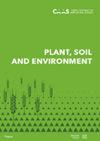氮磷肥配施对水稻氮素吸收利用的影响
IF 1.8
3区 农林科学
Q1 AGRONOMY
引用次数: 0
摘要
氮磷肥对丘陵区水稻氮素吸收和利用的影响。植物土壤环境。,69:25-37。摘要:本研究的目的是研究稻田氮磷平衡施肥策略,并评估其对水稻氮吸收和利用的影响。2017年至2018年,使用德优4727号水稻进行了试验,四种不同的磷水平(0、6.6、13.2和26.4公斤/公顷),依次标记为P0、P1、P2、P3,四个不同的氮水平(0,90、150和270公斤/公顷,类似地依次标记为N0、N1、N2和N3。结果表明,在氮缺乏(N0,N1)的环境中,P1处理增加了氮的吸收并促进了向籽粒的转移。然而,施用高磷(P3)比其他磷水平更能增加干物质的积累,但在一定程度上限制了干物质的产生和迁移。在氮充足(N2,N3)环境中,P2水平使作物产量和氮利用效率分别提高了11.35%和37.01%。与P2不同,非磷(P0)和高磷水平降低了水稻干物质的转运和转运能力,从而进一步影响了氮充足环境中的氮吸收和利用。总的来说,施氮量90公斤/公顷和施磷量13.2公斤/公顷、施氮量150、270公斤/公顷以及施磷量26.4公斤/公顷的组合具有较高的产量;营养物质积累和转移能力强。它更倾向于平衡氮和磷,有利于植物对氮的吸收和利用。本文章由计算机程序翻译,如有差异,请以英文原文为准。
Combined effect of nitrogen and phosphorous fertiliser on nitrogen absorption and utilisation in rice
effect of nitrogen and phosphorous fertiliser on nitrogen absorption and utilisation in rice for hilly areas. Plant Soil Environ., 69: 25–37. Abstract: The objectives of this study were to investigate the nitrogen (N) and phosphorus (P) balance fertilisation strategy in paddy fields and to evaluate the effects on N uptake and utilisation in rice. In 2017–2018, the experiment was conducted using cv. Deyou4727 rice with four different P fertiliser levels (0, 6.6, 13.2, and 26.4 kg/ha), marked as P0, P1, P2, P3 in turn, and four different N levels (0, 90, 150, and 270 kg/ha), similarly marked as N0, N1, N2, N3 in turn. The results showed that in the N-insufficient (N0, N1) environments, the P1 treatment increased N uptake and promoted transfer to the grain. However, high-P (P3) application increased the dry matter accumulation more than other P levels but limited the production and translocation of dry matter to some extent. In N-sufficient (N2, N3) environments, the P2 level increased crop yield and N use efficiency by 11.35% and 37.01%. Unlike P2, none-P (P0) and high-P levels decreased rice dry matter translocation and transport capacity, which further affected N uptake and utilisation in N-sufficient environments. Overall, the combination of the N application rate of 90 kg/ha and P application rate of 13.2 kg/ha, N application rate of 150, 270 kg/ha, and P application rate of 26.4 kg/ha had a high yield; strong nutrient accumulation and transfer ability. It was more inclined to balance N and P, which was beneficial to plant N absorption and utilisation.
求助全文
通过发布文献求助,成功后即可免费获取论文全文。
去求助
来源期刊

Plant, Soil and Environment
Agronomy, Soil Science-农艺学
CiteScore
4.80
自引率
4.20%
发文量
61
审稿时长
2.4 months
期刊介绍:
Experimental biology, agronomy, natural resources, and the environment; plant development, growth and productivity, breeding and seed production, growing of crops and their quality, soil care, conservation and productivity; agriculture and environment interactions from the perspective of sustainable development. Articles are published in English.
 求助内容:
求助内容: 应助结果提醒方式:
应助结果提醒方式:


